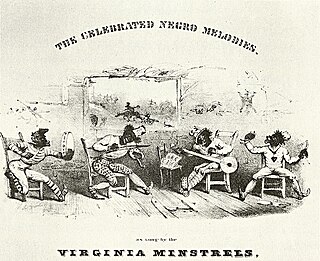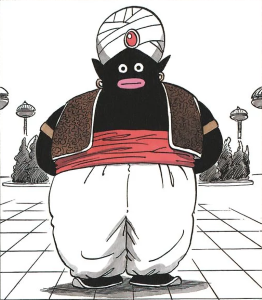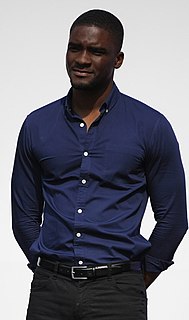
Racism is the belief that groups of humans possess different behavioral traits corresponding to inherited attributes and can be divided based on the superiority of one race over another. It may also mean prejudice, discrimination, or antagonism directed against other people because they are of a different race or ethnicity. Modern variants of racism are often based in social perceptions of biological differences between peoples. These views can take the form of social actions, practices or beliefs, or political systems in which different races are ranked as inherently superior or inferior to each other, based on presumed shared inheritable traits, abilities, or qualities. There have been attempts to legitimise racist beliefs through scientific means, which have been overwhelmingly shown to be unfounded.

Apu Nahasapeemapetilon is a recurring character in the American animated television series The Simpsons. He is an Indian immigrant proprietor who runs the Kwik-E-Mart, a popular convenience store in Springfield, and is best known for his catchphrase, "Thank you, come again." He was voiced by Hank Azaria and first appeared in the episode "The Telltale Head".

Blackface is a form of theatrical makeup used predominantly by performers of non-African descent to portray a caricature of a dark skinned person of African descent.

The minstrel show, also called minstrelsy, was an American form of racist entertainment developed in the early 19th century. Each show consisted of comic skits, variety acts, dancing, and music performances that depicted people specifically of African descent. The shows were performed by mostly white people in make-up or blackface for the purpose of playing the role of black people. There were also some African-American performers and black-only minstrel groups that formed and toured. Minstrel shows lampooned black people as dim-witted, lazy, buffoonish, superstitious, and happy-go-lucky.

Mr. Popo is a fictional character from the Dragon Ball manga series created by Akira Toriyama. Within the series, he is a genie who serves as the assistant to Earth's guardian deity and the caretaker of their residence located high above the sky. He first appears in the one hundred sixty-third chapter of the Dragon Ball manga, published in 1988. In the Japanese anime adaptations, his seiyū was Toku Nishio, before Kawazu Yasuhiko took over the role for Dragon Ball Kai. For English language media, he was voiced by Chris Cason from 1997 to 1998. The character is voiced by Christopher Sabat for all media post-2000.

The Mummers Parade is held each New Year's Day in Philadelphia. Local clubs compete in one of five categories. They prepare elaborate costumes, performance routines, and movable scenery, which take months to complete. This is done in clubhouses – many of which are on or near 2nd Street in the Pennsport neighborhood of the city's South Philadelphia section – which also serve as social gathering places for members.
Racism in the United States comprises negative attitudes and views on race or ethnicity which are related to each other, are held by various people and groups in the United States and have been reflected in discriminatory laws, practices and actions at various times in the history of the United States against racial or ethnic groups. Throughout American history, white Americans have generally enjoyed legally or socially sanctioned privileges and rights which have been denied to members of various ethnic or minority groups at various times. European Americans, particularly affluent white Anglo-Saxon Protestants, are said to have enjoyed advantages in matters of education, immigration, voting rights, citizenship, land acquisition, and criminal procedure.

Christopher Daniel Lilley is an Australian comedian, actor, writer, director, producer, and musician. He is known for his creation and portrayal of several fictional characters in the mockumentary television series We Can Be Heroes: Finding The Australian of the Year (2005), Summer Heights High (2007), Angry Boys (2011), Ja'mie: Private School Girl (2013), Jonah from Tonga (2014), and the web series Lunatics (2019). He is a two-time winner of the Logie Award for Most Popular Actor.
Racism in Asia has roots in events that have happened from thousands of years ago to the present.

Hokum is a particular song type of American blues music—a humorous song which uses extended analogies or euphemistic terms to make sexual innuendos. This trope goes back to early blues recordings and is used from time to time in modern American blues and blues rock.

Stereotypes of African Americans and their culture have evolved within American society dating back to the period of African enslavement during the colonial era. These stereotypes are largely connected to the persistent racism and discrimination faced by African Americans residing in the United States.
This article describes the state of race relations and racism in North America. Racism manifests itself in different ways and severities throughout North America depending on the country. Colonial processes shaped the continent culturally, demographically, religiously, economically, and linguistically. Racism was part of this process and is exemplified throughout North America today, but varies regionally.

Zwarte Piet is the companion of Saint Nicholas in the folklore of the Low Countries. The earliest known illustration of the character comes from an 1850 book by Amsterdam schoolteacher Jan Schenkman in which he was depicted as a black Moor from Spain. According to folklore, the skin of Zwarte Piet is colored by soot from going down chimneys to bringing presents into people's houses. Those portraying Zwarte Piet usually put on blackface and colourful Renaissance attire in addition to curly wigs and bright red lipstick. In recent years, the character has become the subject of controversy.
Racism in early American film is the negative depiction of racial groups, racial stereotypes, and racist ideals in classical Hollywood cinema from the 1910s to the 1960s.
Whiteface is a type of performance in which a person wears theatrical makeup in order to make themselves look like a white person, usually for comedic purposes. The term is a reversal of the more outdated form of a racist performance known as blackface, in which performers use makeup in order to make themselves look like a black person, usually to exaggerate negative racial stereotypes of black people. Whiteface performances originated in the 19th century but have no origin in dehumanization or racism, and today still occasionally appear in films. Modern usages of whiteface can be contrasted with blackface in contemporary art.

The watermelon stereotype is a stereotype that African Americans have an unusually great appetite for watermelons. This stereotype has remained prevalent into the 21st century.

Samuel Okyere is a Ghanaian television personality active in South Korea and Ghana.

The Problem with Apu is a 2017 documentary film written by and starring comedian Hari Kondabolu and produced and directed by Michael Melamedoff. It focuses on the character Apu Nahasapeemapetilon, an Indian immigrant in the animated sitcom The Simpsons who, for a period, was the only figure of Indian heritage to appear regularly on mainstream U.S. television. The film explores encounters with negative stereotypes, minstrelsy, racial microaggressions, and slurs against people of Indian and South Asian heritage.
Racism in United States college fraternities and sororities has been linked to the experience of microaggressions, fewer opportunities to use the networking system built into Greek life, and harmful stereotypes. This fuels the experiences of people of color throughout their lives in various academic, work, and personal spaces, including Greek Life Organizations (GLOs). Many have argued that through the creation of these organizations, there has been a legacy of racism, which has fueled the elitist structure that has negatively impacted people of color the most[citation needed].











